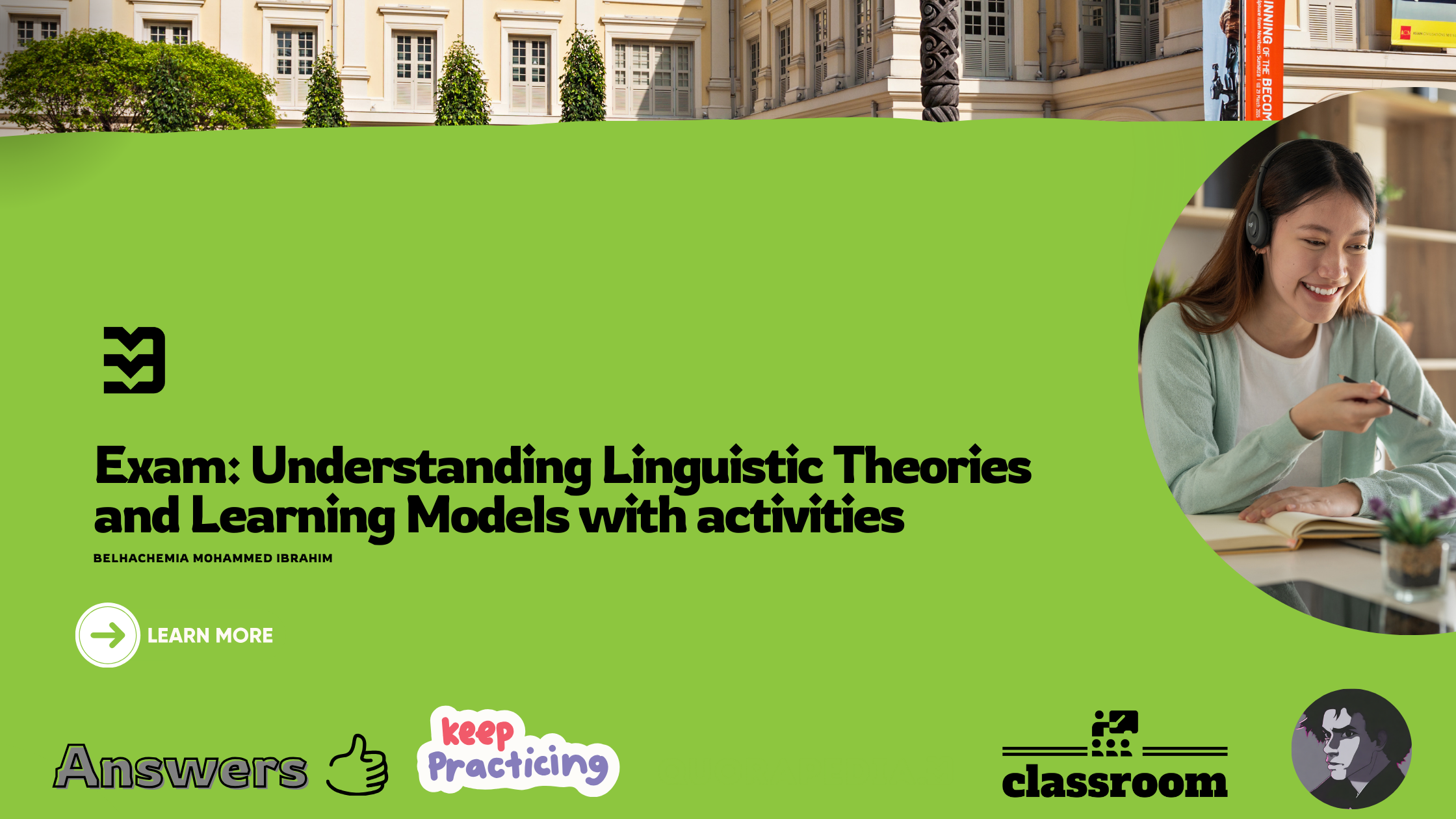
Exam: Understanding Linguistic Theories and Learning Models
Instructions: Answer all questions. The exam consists of three sections, each based on one of the lecture sequences provided in the course material. Provide thorough explanations and examples where applicable to support your answers.

Section 1: Structuralism
Total Points: 30
- (10 points) Explain the basic principles of structuralism as proposed by Ferdinand de Saussure. How does structuralism view the elements of language?
- (10 points) Compare and contrast the approaches of Ferdinand de Saussure and Leonard Bloomfield to structuralism. Highlight the main differences in their theories.
- (10 points) Discuss the significance of the concepts 'langue' and 'parole' in Saussure's theory. How do these concepts contribute to our understanding of language?
Section 2: Functionalism
Total Points: 30
- (10 points) Define functionalism in linguistics and explain its main focus. How does it differ from structuralism?
- (10 points) Discuss Roman Jakobson’s six functions of language. Provide an example for each function to illustrate its use.
- (10 points) Explain M.A.K. Halliday’s concept of the three metafunctions of language. How do these functions help in analyzing language in social contexts?
Section 3: Comparative Analysis of Cognitivism and Constructivism
Total Points: 40
- (10 points) Outline the main features of the Cognitivism theory in learning. How does it address the mental processes involved in learning?
- (10 points) Describe Constructivism according to Lev Vygotsky and his concept of the Zone of Proximal Development. How does this concept function in the learning process?
- (10 points) Compare and contrast Cognitivism and Constructivism in the context of active learning. What are the key similarities and differences in their approaches?
- (10 points) Discuss the role of problem-solving and critical thinking in both Cognitivist and Constructivist theories. How do these elements influence teaching practices according to each theory?
Section 1: Structuralism
- Basic Principles of Structuralism by Ferdinand de Saussure:
- Structuralism views language as a system of interrelated elements, where each element's meaning is defined not inherently but through its relationships with other elements.
- It emphasizes that language is a structure of signs, each consisting of a "signifier" (sound pattern) and a "signified" (concept). This relationship is arbitrary.
- Saussure proposed a synchronic approach to studying language, focusing on the system at a particular point in time rather than its historical development.
- Comparison of Ferdinand de Saussure and Leonard Bloomfield:
- Saussure focused on the underlying structure of language and its use within a particular linguistic community, emphasizing the study of langue (the system of language) over parole (actual speech).
- Bloomfield, on the other hand, emphasized empirical and observable data in language study, focusing on how language operates in real-life situations, thus often engaging in both synchronic and diachronic analysis.
- Significance of 'Langue' and 'Parole':
- 'Langue' refers to the social aspect of language—the system and norms shared by a community, which makes communication possible.
- 'Parole' refers to individual speech acts—the specific utterances made by individuals.
- These concepts help in understanding that while individual speech acts can vary greatly, they are all made possible by underlying shared norms of the langue.
Section 2: Functionalism
- Definition and Focus of Functionalism:
- Functionalism considers language primarily as a tool of communication, focusing on the functions language serves in social contexts.
- It differs from structuralism by not just studying the structures of language but also emphasizing how these structures are used to perform various communicative functions.
- Roman Jakobson’s Six Functions of Language:
- Referential: Language used to convey factual information, e.g., "The sky is blue."
- Emotive (Expressive): Expresses the speaker's emotions, e.g., "Wow, I love this!"
- Conative: Aimed at influencing the listener, e.g., "Please close the door."
- Phatic: Maintains communication, e.g., "You know what I mean?"
- Metalinguistic: Discusses language itself, e.g., "The term 'phatic' means..."
- Poetic: Focuses on message form for aesthetic purposes, e.g., poetry.
- M.A.K. Halliday’s Metafunctions of Language:
- Ideational: Language as a tool to represent the world.
- Interpersonal: Language as a tool for social interaction.
- Textual: Language as a tool for structuring and organizing information.
- These functions highlight how language is used in different contexts, serving different needs from expressing experiences to interacting socially.
Section 3: Comparative Analysis of Cognitivism and Constructivism
- Main Features of Cognitivism:
- Cognitivism sees learning as an active process of acquiring, processing, and organizing information.
- It emphasizes mental processes such as memory, problem-solving, and information processing.
- Constructivism According to Lev Vygotsky:
- Vygotsky's constructivism focuses on the social context of learning, proposing that knowledge is constructed through social interaction.
- The Zone of Proximal Development (ZPD) is the gap between what a learner can do alone and what they can achieve with guidance, emphasizing the importance of scaffolding in learning.
- Comparison of Cognitivism and Constructivism in Active Learning:
- Both theories emphasize active engagement in learning but differ in focus. Cognitivism stresses internal mental processes, while Constructivism emphasizes learning through experiences and social interactions.
- Role of Problem-Solving and Critical Thinking:
- Both theories value problem-solving and critical thinking. Cognitivism focuses on the development of these skills through cognitive strategies and mental models, while Constructivism emphasizes real-world contexts and the social construction of knowledge.
Questions
Section 1: Structuralism
- Who is considered the father of structural linguistics?
- A) Noam Chomsky
- B) Leonard Bloomfield
- C) Ferdinand de Saussure
- D) Roman Jakobson
- Which concept did Saussure NOT develop in his linguistic theory?
- A) Syntagmatic relations
- B) Langue and parole
- C) Phonemes
- D) Zone of Proximal Development
- What does 'langue' refer to in Saussure's theory?
- A) Individual speech acts
- B) The formal structure of language
- C) The virtual system shared by a community
- D) Historical development of language
- Saussure's approach to linguistics is primarily:
- A) Diachronic
- B) Synchronic
- C) Phenomenological
- D) Ethnographic
- Leonard Bloomfield’s structuralism emphasized:
- A) Language as a system of signs
- B) Language as behavior and empirical analysis
- C) The cognitive processes of language
- D) The social functions of language
Section 2: Functionalism
- Functionalism in linguistics primarily studies:
- A) The history of linguistic forms
- B) The structure of linguistic systems
- C) The communicative functions of language
- D) The evolution of language across cultures
- Roman Jakobson identified how many functions of language?
- A) Four
- B) Six
- C) Five
- D) Three
- Which function of language relates to maintaining social connections?
- A) Referential
- B) Phatic
- C) Emotive
- D) Conative
- M.A.K. Halliday introduced which linguistic theory?
- A) Pragmatics
- B) Systemic Functional Linguistics
- C) Cognitive Linguistics
- D) Sociolinguistics
- The ideational function in Halliday’s theory refers to:
- A) The creation of textual coherence
- B) The expression of social relationships
- C) The representation of reality
- D) The organization of speech acts
Section 3: Comparative Analysis of Cognitivism and Constructivism
- Which theory emphasizes the active construction of knowledge?
- A) Behaviorism
- B) Cognitivism
- C) Constructivism
- D) Functionalism
- Who proposed the Zone of Proximal Development?
- A) Piaget
- B) Vygotsky
- C) Skinner
- D) Bandura
- Cognitivism views learning as:
- A) A behaviorist conditioning process
- B) A social interaction
- C) An active mental process
- D) A passive absorption of knowledge
- Constructivism stresses the importance of:
- A) Reinforcements in learning
- B) Social contexts in learning
- C) Biological predispositions
- D) Fixed curriculum standards
- What does cognitivism focus on that constructivism does not?
- A) Social interactions
- B) Mental processes
- C) External behavior
- D) Cultural tools
Answers
- C - Ferdinand de Saussure
- D - Zone of Proximal Development
- C - The virtual system shared by a community
- B - Synchronic
- B - Language as behavior and empirical analysis
- C - The communicative functions of language
- B - Six
- B - Phatic
- B - Systemic Functional Linguistics
- C - The representation of reality
- C - Constructivism
- B - Vygotsky
- C - An active mental process
- B - Social contexts in learning
- B - Mental processes
Matching Exercise: Sentences and Definitions
Sentences:
- "The rapidly flowing river prevented us from crossing."
- "She applied for the grant in hopes of funding her research."
- "Cats, which are often independent, can also be very affectionate."
- "Despite the rain, the event was well-attended."
- "He adapted quickly to the new software."
- "They argued about whether to go hiking or biking."
- "Her dissertation explores the impact of social media on self-esteem."
- "The sun sets earlier during the winter months."
- "He reluctantly agreed to chair the committee."
- "The experiment requires precise measurements."
Definitions:
A. A statement that provides an example or specifies a particular case of a more general concept.
B. An action taken to achieve a particular purpose, often formal or bureaucratic.
C. A statement that includes a conditional clause or shows a circumstance despite which something occurs.
D. A scientific procedure conducted to test a hypothesis or demonstrate a known fact.
E. A temporal description indicating a change or pattern over time. F. An expression of a behavioral trait or characteristic that might not be universally observable.
G. A process or activity involving a detailed examination of a subject or topic of study. H. A situation described where an action is influenced by hesitation or reluctance. I. A description of an environmental or situational obstacle. J. A decision-making conversation involving different preferences or opinions.
Matches:
- I - "The rapidly flowing river prevented us from crossing." (Describes an environmental obstacle)
- B - "She applied for the grant in hopes of funding her research." (Action taken for a specific purpose)
- F - "Cats, which are often independent, can also be very affectionate." (Behavioral trait description)
- C - "Despite the rain, the event was well-attended." (Conditional circumstance)
- A - "He adapted quickly to the new software." (Example of a general concept of adaptability)
- J - "They argued about whether to go hiking or biking." (Decision-making discussion)
- G - "Her dissertation explores the impact of social media on self-esteem." (Detailed examination of a topic)
- E - "The sun sets earlier during the winter months." (Temporal change or pattern)
- H - "He reluctantly agreed to chair the committee." (Action influenced by reluctance)
- D - "The experiment requires precise measurements." (Scientific procedure)






